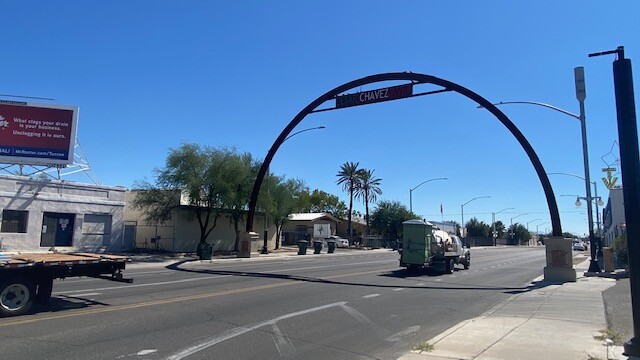FIVE POINTS, Tucson — Standing in Downtown Tucson, you see how old buildings with history exist among more modern offices and apartments.
Only three minutes from Hotel Congress, down Sixth Avenue, you'll then see arching monuments to a community that’s lived, worked and celebrated there for generations.
Good Morning Tucson went to Five Points to celebrate the corners and their respective barrios ahead of Road Show Week.
We asked two men with deep roots in the barrios about the history that’s changed the neighborhoods to what they are now, and why it’s important to learn from it.
"Here's where Tucson began: in the barrio," Pedro Gonzales said. "It didn't start downtown. It started right there on Meyer Street." Gonzales and his family moved to Meyer Street back in 1960 and he’s kept his roots there since.
He said he remembers how these cross streets were a beating heart of culture and commerce; five points, connecting Tucson to the rest of southern Arizona.

"Initially, it's a state route," he said, "and this state route will take you all the way to Nogales before they had a freeway." Just like Gonzales, artist Luis Mena used to run and play on the streets that connect barrios Santa Rita, Santa Rosa, Barrio Viejo and Armory Park.
"I was raised here. I lived here... in these barrios. Tastee-Freez was here," Mena said as he pointed to several of the intersection's corners. "Circle K was there, Flash TV was over here."

Both men's love and passion for this community is evident. Mena designed the art installation that was finished in 2021. As drivers cruise by, massive arches will welcome cars. At the sculpture's bases, they'll then find etchings of women working in traditional clothing.
Mena, however, said he's quick to recognize neighbors before him fought to get these monuments built; to get their own history recognized. "(People) have been fighting to get these arches that are over 60 feet... it took, what 30 years? Almost 30 years?" he said.
"The struggle and the fight... I'm just the newcomer (with) them picking the artist." It’s a fight both men say began in earnest in the 60s.
The Good Morning Tucson team looked back at KGUN'S reporting and City of Tucson policies from that decade. The Urban Renewal drive forced many families out and replaced their homes with the Tucson Convention Center.
"What the City of Tucson did with urban removal -- it wasn't urban renewal to us," Gonzales said. "It was urban removal."
"Some of them did sell, but most of the families (left) in one leap and there was a lot of families that their grandfather or husband... the señores who built their own homes."
Gonzalez said some families like his have stayed. He’s doing their best not just to preserve the history of the barrios, but teaching younger generations about these working-class neighborhoods.

"We still have our schools here and we still have our churches," Gonzales said. "(Meeting) with college students twice a year... I do talk to them about about the barrios and how we got to this point."
Gonzales said there’s another struggle to keep the neighborhoods' distinct character. We also found an old story KGUN's Craig Smith reported, when newer Barrio Viejo residents agreed with Gonzales’ sentiment: home-buyers and business owners may be too keen to go modern and forget the rich history here.
Mena and Gonzales have invited me to come back and learn all sorts of people’s stories and journeys.
"Without history, you don't have a heart and a soul," Mena said. "How are you going to know how you exist if you don't know where you're coming from, in the present, to go into the future?"






